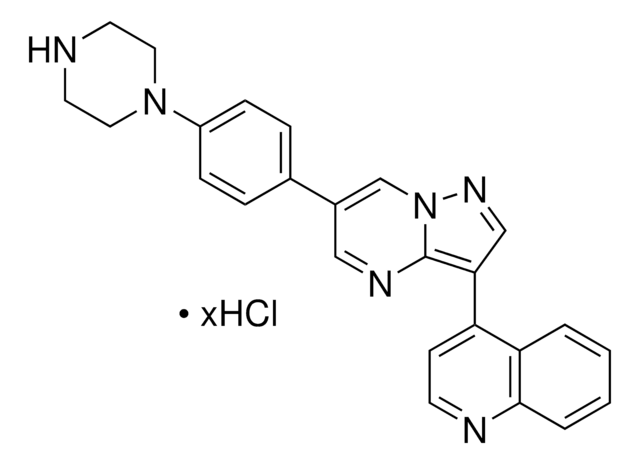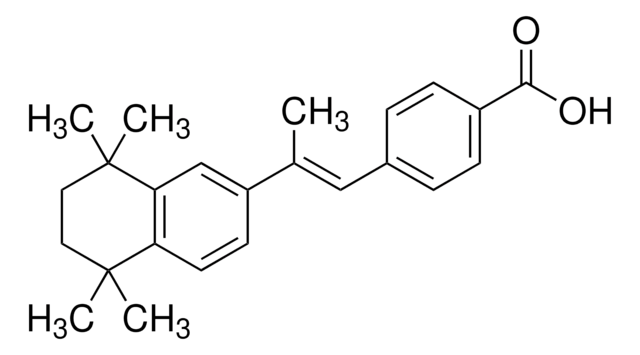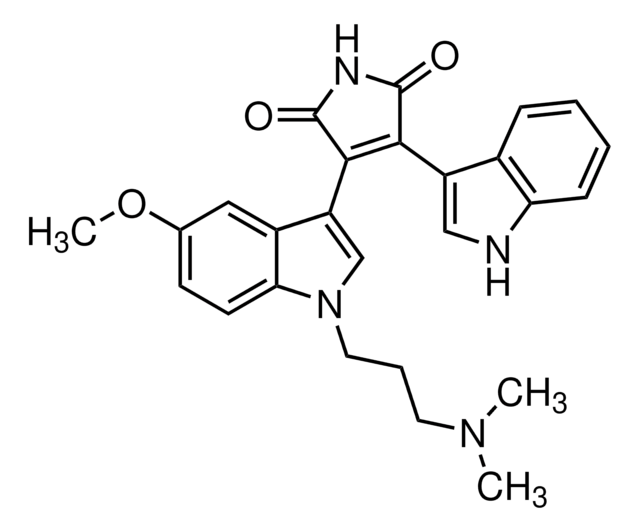524390
Phorbol 12,13-dibutyrate
≥99% (HPLC), solid (crystalline), PKC activator, Calbiochem
Sinônimo(s):
Phorbol-12,13-dibutyrate, PDBu, PKC Activator II
About This Item
Produtos recomendados
product name
Phorbol-12,13-dibutyrate, Strong irritant for mouse skin, but only moderately active as a tumor promoter.
Nível de qualidade
Ensaio
≥99% (HPLC)
forma
solid (crystalline)
fabricante/nome comercial
Calbiochem®
condição de armazenamento
OK to freeze
cor
white to pale yellow
Condições de expedição
ambient
temperatura de armazenamento
−20°C
InChI
1S/C28H40O8/c1-7-9-20(30)35-24-16(4)27(34)18(22-25(5,6)28(22,24)36-21(31)10-8-2)12-17(14-29)13-26(33)19(27)11-15(3)23(26)32/h11-12,16,18-19,22,24,29,33-34H,7-10,13-14H2,1-6H3/t16-,18+,19-,22-,24-,26-,27-,28-/m1/s1
chave InChI
BQJRUJTZSGYBEZ-YVQNUNKESA-N
Descrição geral
Ações bioquímicas/fisiológicas
Na+,K+- ATPase
Embalagem
Advertência
Nota de preparo
Reconstituição
Outras notas
Lee, E.J., et al. 1994. Brain Res. 665, 127.
Critz, S.D., et al. 1993. J. Neurochem.60, 1175.
Iredale, P.A., et al. 1993. Biochem. Pharmacol.45, 611.
Critz, S.D., and Byrne J.H. 1992. J. Neurophys.68, 1079.
Hortelano, S., et al. 1992. J. Biol. Chem. 267, 24937.
Ward C.A., and Moffat, M.P. 1992. J. Mol. Cell. Cardiol.24, 937.
Informações legais
Palavra indicadora
Danger
Frases de perigo
Declarações de precaução
Classificações de perigo
Acute Tox. 1 Dermal - Acute Tox. 1 Inhalation - Acute Tox. 2 Oral - Carc. 2 - Eye Dam. 1 - Resp. Sens. 1 - Skin Corr. 1B - Skin Sens. 1
Código de classe de armazenamento
6.1A - Combustible acute toxic Cat. 1 and 2 / very toxic hazardous materials
Classe de risco de água (WGK)
WGK 3
Ponto de fulgor (°F)
Not applicable
Ponto de fulgor (°C)
Not applicable
Certificados de análise (COA)
Busque Certificados de análise (COA) digitando o Número do Lote do produto. Os números de lote e remessa podem ser encontrados no rótulo de um produto após a palavra “Lot” ou “Batch”.
Já possui este produto?
Encontre a documentação dos produtos que você adquiriu recentemente na biblioteca de documentos.
Os clientes também visualizaram
Nossa equipe de cientistas tem experiência em todas as áreas de pesquisa, incluindo Life Sciences, ciência de materiais, síntese química, cromatografia, química analítica e muitas outras.
Entre em contato com a assistência técnica












